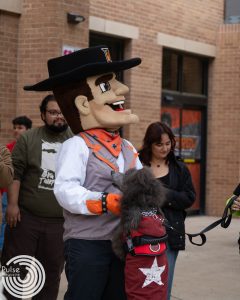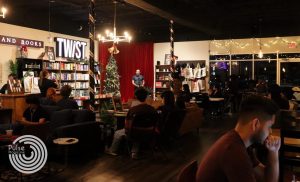Rio Grande Valley Cities to Require Masks
While walking around Edinburg, there two or more people seen with a variety of masks. They have colorful designs such as halves of lemons on a yellow background or a simple surgical mask. Inside stores the number of people using them is doubled, even triple. Additional designs are seen, some made from home. Chatter in the store is muffled by masks. The employees wear simple white foam masks and light-blue surgical gloves; they’re distancing themselves from costumers during check out by a transparent plastic barrier.
The city of Edinburg began enforcing a new policy that requires all residents to wear masks, enacted on April 6. This comes after the Hidalgo County Judge, Richard F. Cortez, issued a shelter-at-home order, which started at 11:59 p.m. March 26 and is scheduled to end at 11:59 p.m. April 30. As previously mentioned by Pulse Magazine, the coronavirus was reported on Dec. 2019 in Wuhan, China. The Centers for Disease Control and Prevention recommends the general public make masks from home instead of buying surgical or N95 masks; making one can be done with an old T-shirt, a bandana, or a scarf. The U.S. Food and Drug Administration reported that those are critical supplies that health care workers, and other medical first responders, need.
According to a press release from the City of Edinburg, there is a $1,000 fine and possible jail time for those who don’t wear masks.
“Any type of face covering that covers your nose and mouth is compliant,” the press release stated. “Simple [clothes], like a scarf, bandana or handkerchief that cover the mouth and nose can help prevent virus transmission in public settings.”
It is only required to wear the mask in nonresidential areas such as parking lots or at gas stations. They do not need to be worn in vehicles, alone in an enclosed space or when exercising outdoors.

Shyla Pena, an Edinburg resident, said that although the timing of notifying the city community was late, she does not mind the order because of her past experiences living in areas where wearing face masks were a common thing, such as Japan.
“I think the scariest part about this is that others never got that chance to find their face masks [and are] being reprimanded for something they had no control [over],” Pena said. “People are going to want to go out to look for masks. It’s going to create a citywide panic again. It seems like a good idea, but I also believe it’s going to do more harm than good.”
After the order started, stores such as a Walmart in Edinburg enforce it. Raul Passamentt Jr., a dance freshman at the UTRGV, encountered this. As he walked from the parking lot to the entrance but was stopped by a Walmart employee. The employee told the student he couldn’t come into the store without a mask. He left and returned with a face mask.
“I did get bothered at first, but they are just following rules and doing their job,” Passamentt said.
Other cities such as Mission, are following this precaution. The city’s mayor, Armando O’ Caña, took to Twitter on April 5, 2020, to declare the order starts immediately.
“We understand this isn’t the perfect solution,” Caña said. “We’re doing our best to follow CDC guidelines and safeguard our community.”
Similarly, the city of Elsa also began requiring the use of a face mask on that same day. However, it took effect at 5 a.m. April 6, 2020.
Another city to make this order is Palmview, who announced the policy the same day as the city of Edinburg. However, Palmview’s order went into effect that same day. The CDC created a graphic that explains the differences between surgical and N95 masks. According to the PDF, the intended use of the one-time-use surgical mask is preventing biohazard-fluid entering the body via the mouth and nose. The N95 mask reduces the wearer’s exposure to small particles and large droplets.

The PDF also mentioned N95 masks are required to fit testing and the surgical masks are not. This test is conducted to assure the respirator is both comfortable and fits the user by the Occupational Safety and Health Administration, according to the CDC. The test is conducted annually by OSHA.
“The benefits of a fit test [includes] better protection for the employee and verification that the employee is wearing a correctly-fitting model and size of respirator,” written in the PDF. “Higher than expected levels of exposure to a contaminant may occur if the respirator has a poor face seal against the user’s skin, which can result in leakage.” On the World Health Organization’s coronavirus webpage, there is an outline on preventive measures and how to slow transmission of the virus. The bullet list stated to wash hands regularly with soap and water, or clean them with alcohol-based hand sanitizer, practice social distancing, cover the mouth and nose when coughing or sneezing, stay home if sick, among other recommendations.
The Rio Grande Valley leadership made these orders after news of additional cases of the coronavirus. As of April 14, Cameron County has 216 cases; 198 cases in Hidalgo County; 7 cases in Starr County; and 5 cases in Willacy County, according to the Texas Department of State Health Services.
Then, as of April 14, 2020, Willacy County reported a man in his 60s died. Cameron County reported its first death of the new virus, an 81-year-old from the Veranda nursing Home in Harlingen and had been hospitalized at Valley Baptist Medical Center in Harlingen, where there’s been two additional deaths and 73 people been cleared of COVID-19. Hidalgo County reported its first death from coronavirus, a 76-year-old Alamo man; 37 people have been cleared of the virus. Starr County reported 4 people recovered from the virus.





